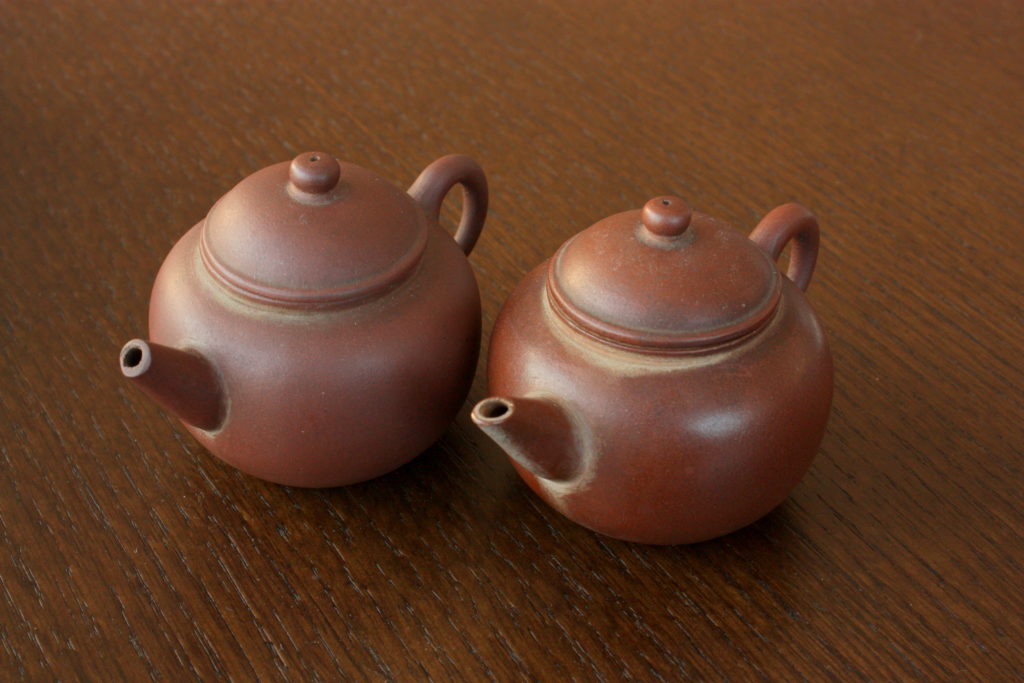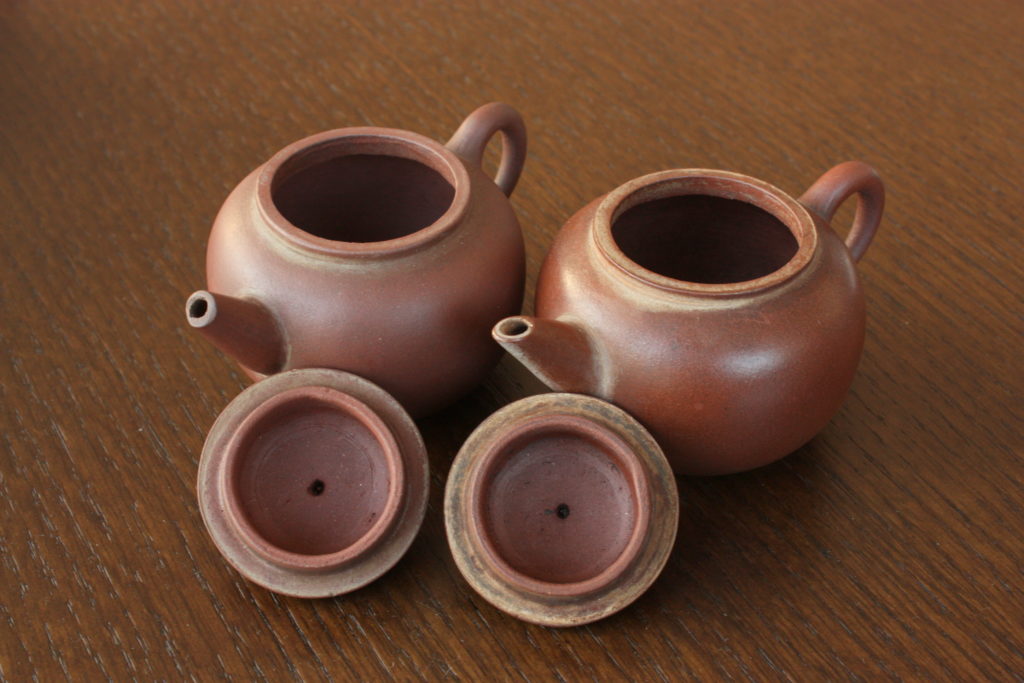How to season teapots? That was one of the comments on my last post. It’s actually not that difficult, although advice on the internet being what they are, and just from the first page of google results looking for “how to raise a yixing teapot“, I see some instructions that are of dubious utility (the first link, funny enough, has pictures of a ceramic cup, not yixing pot, and the second step of the second set of instructions is a death wish for a pot, as I will explain shortly). The basic premise is – keep it simple, and don’t do anything that will endanger your pot.
Before you use the pot, the instructions will tell you to do the following:
1) Clean the pot. 2) Boil it. 3) Brew some tea in it and then discard the tea. 4) Use
Now, the general outline of this I can agree with. Cleaning the pot is simple enough – wash it with water and clean out any debris that might be in the pot, which in brand new pots is often present. If you’re buying antiques or older pots, you may need to do more deep cleaning – ranging from acid baths to bleach baths. For pots that are new, that’s unnecessary.
I think I have, at some point in the life of this blog, also mentioned the need to boil a teapot. I have to say I no longer think boiling is a good idea, and since it is a very risky activity, I do not encourage people to do it unless they have a death wish for their pot. I have personally damaged two of my pots in the process of boiling them, and I am not sure if there’s any good reason to do so that cannot be achieved just by soaking the pot in very hot water for an hour in a pan/bowl that has been pre-warmed (along with the pot) and covered and perhaps insulated. The theory behind boiling the pot is that it opens up the (some say mythical) pores on the surface of the pot and “prime” them for seasoning. I’m not sure of the truth of this need – but if you believe in it, I think a hot soak will do the trick.
The problem with boiling is that even if you simmer, at the lowest heat, the water will still bubble up, unless your heat is so low that the water is kept only warm, and not hot, in which case you are doing what you can do with just a covered bowl with no heat source. When the water bubbles, however, the parts of the teapot in the pan will rattle, either a little or a lot, depending on your luck, and once in a while, it will rattle in such a way as to damage it – usually the victim is the tip of the spout or the edge of the lid. If you insist on boiling, start with cold water with the pot already in the pan and heat everything up, very slowly, together. Putting the pot in boiling water, like Verdant suggests, is extremely risky. Putting anything extra, like a spoon in the pot (as they also suggest) is even riskier – the less things the pot can knock against, the better. I know people here who boil with some elaborate contraption they’ve devised with wet towel lining the inside of a rice cooker or something along those lines. I, frankly, don’t see the point.
Whatever your belief regarding yixing clay’s porosity, I can personally attest that they do soak up smell very well. For example, the pair of pots in my last post – I just tried, for the sake of experimentation, to brew some tea in the relatively unseasoned pot the other day without doing any cleaning. What I got was a slightly salty and old-sock like smell from the pot and the tea – and the tea did not recover even when I transferred it to another brewing vessel. This tells me I needed to clean it, and it also tells me what many yixing users already know – the pots do, over time, take on smells. In this case, it’s the musty smell of whatever storage facility it was in.
So having picked a tea to use the pot with (I’d generally suggest wide genres – oolongs, pu, black, greens, and not be too fussy with specificity – as in a previous post) I normally will actually soak the pot in said tea – spent leaves are fine – for some time, usually a few hours at a time, and refresh if deemed necessary. This should drive away the fresh clay smell (a mixture of sandy and clay-y). Then, your pot is more or less ready to use.
When using it, I almost never pour water over the pot, nor tea. There’s a reason for this, especially if your water source is high in minerals – over time, there will be a nasty ring of mineral deposits on your pot, usually right around the edge of the rim of the lid. This rim will be difficult to clean. The point of using the brush, as some of you might have seen people do, is to distribute the water evenly throughout the pot, so that this line of mineral doesn’t form (or at least, form a lot slower). Also, as a good chemist friend pointed out a long time ago, pouring water over a pot actually helps it to lose heat faster – that water evaporating off the surface of the pot is taking heat away from your pot. I do not believe that there is any tangible and discernable benefit to pouring water over the pot. Some believe the extra heat (if any) will help get more flavour out of the tea, but since your infusions are quick (a few seconds) and the difference in temperature between water in the pot and water-on-pot is minimal (a few degrees, at most?) I have a hard time imagining a physical process that will help you extract meaningful amounts of flavour out of the leaves in that short period of time.
Now, you will often read about the need to polish your pot, usually with the suggestion of using a wet towel, maybe with tea, after every single use. I normally don’t do this either, for another reason – very frequent use of a wet towel to polish your pot will result in what people often call, derisively, “the monk shine.” 和尚光 This is in reference to a Buddhist monk’s shiny, hairless head (although in reality, any bald head will do). Pots that have been over-buffed will be really shiny. Some people prefer it that way, others think it crass. The right hand pot in my last post, in person at least, is borderline “monk shine.” Personally, I prefer my pots seasoned but not shiny – like the lion pot here. If cleaning is a must (and sometimes it is – because of stains, etc) wet a cloth with warm water, and wipe, gently, the pot while it is warm.
When done drinking, clear the pot of leaves and rinse it out if you wish. Whatever you do, please do keep the lid off until the pot is absolutely dry. I know people who close the lid while it’s still wet because they want to season the inside. Sometimes it’s tea in there, other times it’s wet with clear water, but even then, when I open the lid of those pots, sometimes I can smell a bit of an off smell – mold. It’s far too easy to grow something in a pot if it’s wet and closed. Dry it out. If you use your pot often enough, it’ll season through use. There’s no need to rush, and if you forgot to clear the pot just once, you’ll have to start over by cleaning it inside out. There’s nothing worse than realizing that you forgot some tea in a pot you left around because you wanted to season it, and to discover that what was tea has now turned into a gooey, sickly smelling gel-like substance. I’ve done it before, and it’s nasty. Clean, and keep the lid off.
Finally, a word of etiquette – I was chided a long time ago for doing this by friends with far more experience. If you are drinking tea with friends and you want to admire someone else’s pot, ask before you pick it up, and when you pick it up, keep either the lid or the body on the table when you look at the other part of the pot. Never, ever hold the pot in one hand while you hold the lid in the other (or worse, the same hand) when you’re peering into the pot. Even if you think you have steady hands, all it takes is one accident. Two hands on one pot or one lid is far better than thumb and index on the lid’s knob while your hand holds the pot itself. It’s someone else’s pot, and someone else’s effort – the pot might not be worth a lot, but the time and effort and the memory it comes with are not replaceable. Minimize the risk to others by respecting their wares. You can always break your own teapots.
Addendum: A friend also suggested I add two things to the etiquette section. The first is don’t knock someone else’s pot against itself – in other words, don’t use the lid and hit the body of the pot with it. Yes, some people do that to test to see if the pot rings, but yes, it sometimes can damage the lid or the body of the pot. It happens, and you don’t want to be the one doing it. The other thing not to do is to start doing water tests or whatever else tests you do with pots as if you’re buying them – it’s someone else’s pot. They already bought it. Unless they asked you to evaluate it, don’t. You don’t size up someone’s kid (or cat, or car) and start testing their IQ or kicking the tires, so why would you do that with a teapot?






Yeah whisky prices have been leaking too, as well as luxury watches. I wrote a post maybe a decade ago…